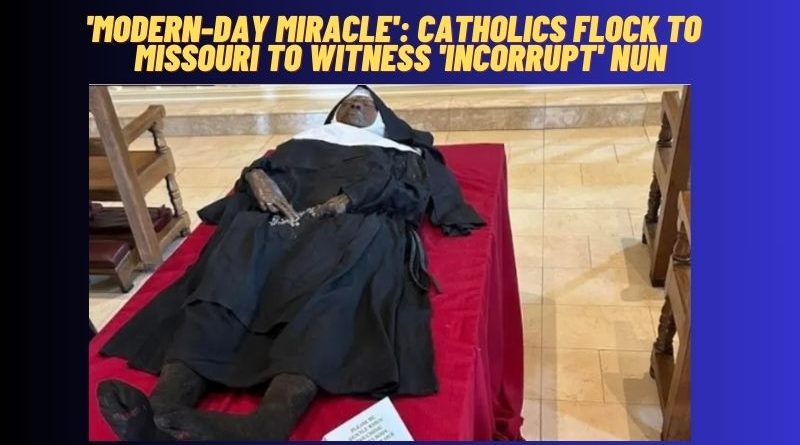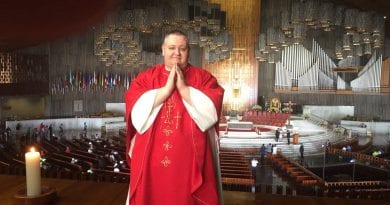‘MODERN-DAY MIRACLE’: CATHOLICS FLOCK TO MISSOURI TO WITNESS ‘INCORRUPT’ NUN
Four years after her death, the body of Sister Wilhelmina Lancaster has not decomposed, her fellow nuns said. Believers come from all over to see for themselves.
WHY WE’RE HERE
In life, Sister Wilhelmina Lancaster was known to her fellow nuns for her devotional poetry, her sense of humor and her fierce piety. “I’m Sister Wil-hel-mina,” she was known to say. “I’ve a hell of a will and I mean it!” A biography published by her order after her death at age 95 in 2019 described her as the little nun “who persevered in faith.”
In death, Sister Wilhelmina has become something much larger to some: a potential saint, a pilgrimage attraction, a miracle.
The transformation started this spring at the Abbey of Our Lady of Ephesus, run by the Benedictines of Mary, Queen of the Apostles, a small but growing conservative order whose headquarters are nestled in the rolling hills north of Kansas City. Four years after burying Sister Wilhelmina, the order’s founder, in a simple wood coffin in a corner of the property, the sisters decided to move her body into a customary place of honor inside their church.
When they opened the coffin, expecting to find bones that could be easily cleaned and placed in a new box, they instead found what looked and even felt remarkably like Sister Wilhelmina herself. Her face was recognizable, even after years in a damp coffin, and the sisters said that her beloved habit was “immaculate.”
For the Benedictines of Mary, this immediately signaled that Sister Wilhelmina may be an “incorruptible,” a term the Catholic Church uses to describe people whose bodies — or parts of their bodies — did not decompose after death. Believers in the phenomenon say there have been more than 100 examples worldwide, mostly in Europe.
Michael O’Neill, who hosts a national radio show called “The Miracle Hunter” on the Catholic station EWTN, said that the case of Sister Wilhelmina, who was Black, was especially distinctive. “There’s never been an African-American incorruptible; in fact there’s never been an American of any sort who’s an incorruptible,” he said. “So this is big news.”
Word began to spread in Catholic circles locally, and then more widely.
The sisters turned an alfalfa field into an impromptu parking lot, and put up hand-lettered signs directing guests to Sister Wilhelmina’s now-empty gravesite, and to her body in the church. Huge crowds — the sisters say at least 25,000 people — streamed into the abbey over Memorial Day weekend to view the body, touch it and pray.
“I used to think something like this could only happen in Europe, or St. Louis,” said Edith Riches, 13, who volunteered that weekend handing out cold water and fruit to visitors waiting in line along the abbey’s long gravel driveway. Volunteers also distributed veils and knee-length skirts to women in the line, to help them meet the abbey’s firm dress code.
The mayor of Gower, Ken Pike, worked with authorities in two counties and the state highway patrol to plan for the influx of visitors, temporarily turning the two-lane road that leads to the abbey into a one-way route. The town also added a large link to the abbey on the top of its website in May, right under its slogan, “A nice place to call home.”
Sister Wilhelmena became the biggest news in town since the high-school football team won the state championship last year for the second time in a row.
But quiet downtown Gower, a town of about 1,500 people where $1.50 buys you a cold can of beer at happy hour, experienced little of the hubbub. The abbey is about six miles from there, so relatively few tourists ended up making their way into town.
After Memorial Day, the nuns enclosed Sister Wilhelmina’s body in a glass box, which they installed in the church on their property in view of the pews where visitors sit during Mass. The volume of visitors dropped, but then remained steady.
When I visited the abbey on a Thursday in August, about 75 people attended midday Mass at the church, a sizable turnout for a weekday service. I met pilgrims from Minnesota, Texas and California, some passing through on summer road trips. One woman snapped pictures of the body, saying she would check back on Sister Wilhelmina’s condition in a few years.
In life, Sister Wilhelmina was the descendant of enslaved Catholics, and grew up in a Catholic family in St. Louis. She belonged to a traditionally Black order of nuns for 50 years, the Oblate Sisters of Providence. But by the end of that time, she was disillusioned by what she perceived as a loosening of standards in worship and clothing styles. She founded the new traditionalist order in the 1990s.





